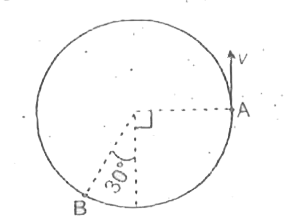If a cyclist takes one minute to complete half revolution on a circular path 120 m radius. What is the average velocity?
1 m/s
2 m/s
3 m/s
4 m/s
The correct Answer is:D
To solve the problem of finding the average velocity of a cyclist who completes half a revolution on a circular path with a radius of 120 meters in one minute, we can follow these steps:
1. Understand the Motion: The cyclist completes half a revolution on a circular path. This means that if we visualize the circular path, the cyclist starts from one point on the circumference and ends at the point directly opposite (diametrically opposite) after half a revolution.
2. Calculate the Displacement: The displacement is the straight-line distance between the starting point and the ending point. For half a revolution, this distance is equal to the diameter of the circle.
- The formula for the diameter D of a circle is:
D=2×R
- Given that the radius R is 120 meters:
D=2×120=240 meters
3. Determine the Total Time: The time taken to complete half a revolution is given as one minute. We need to convert this time into seconds for our calculations.
- Since 1 minute = 60 seconds, we have:
Total time=60 seconds
4. Calculate the Average Velocity: The average velocity Vavg is defined as the total displacement divided by the total time taken.
- Using the formula:
Vavg=Total DisplacementTotal Time
- Substituting the values we found:
Vavg=240 meters60 seconds=4 meters/second
5. Conclusion: Therefore, the average velocity of the cyclist is:
Vavg=4 m/s
- The formula for the diameter D of a circle is:
D=2×R
- Given that the radius R is 120 meters:
D=2×120=240 meters
- Since 1 minute = 60 seconds, we have:
Total time=60 seconds
- Using the formula:
Vavg=Total DisplacementTotal Time
- Substituting the values we found:
Vavg=240 meters60 seconds=4 meters/second
Vavg=4 m/s
Topper's Solved these Questions
- MOTION IN A STRAIGHT LINE BOOK - AAKASH SERIESCHAPTER - MOTION IN A STRAIGHT LINE EXERCISE - PRACTICE EXERCISE
58 Videos
- MOTION IN A STRAIGHT LINE BOOK - AAKASH SERIESCHAPTER - MOTION IN A STRAIGHT LINE EXERCISE - problems
47 Videos
- MOTION IN A STRAIGHT LINE BOOK - AAKASH SERIESCHAPTER - MOTION IN A STRAIGHT LINE EXERCISE - EXERCISE -I
58 Videos
- MOTION IN A PLANEBOOK - AAKASH SERIESCHAPTER - MOTION IN A PLANEEXERCISE - QUESTION FOR DESCRIPTIVE ANSWER
7 Videos
- MOVING CHARGES AND MAGNETISMBOOK - AAKASH SERIESCHAPTER - MOVING CHARGES AND MAGNETISMEXERCISE - EXERCISE-III
49 Videos
Similar Questions
Earth completes one revolution round the sun in 365.25 days. What is the angular velocity ?
View SolutionA satellite moving in a circular orbit at an altitude of 1000 km completes one revolution round the earth in 105 minutes. What is (z) its angular velocity and speed? Radius of the earth =6.4×106m.
View Solution
Knowledge Check
A cyclist moving a car circular track of raidus 40 cm completes half a revolution in 40 s. Its average velocity is
AzeroB4πms−1C2cms−1D8πms−1
A rotating, rigid body makes one complete revolution in 2s. What is its average angular velocity?
View SolutionA tangential force of F = 1.5 N acts on a particle of mass m = 2 kg revolving in a circular path of radius r = 3 m. What is the work done by the torque for a complete revolution of the particle ?
View SolutionA particle travels two and a half revolutions of the circle of radius R in time t. The ratio of the average speed of the particle to the magnitude of the average velocity in this time interval is
View SolutionA body is orbitting around the earth at mean radius 9 times as great as the orbit of a geostationary satellite to how many days it will complete one revolution around the earth and what is its angular velocity ?
View SolutionA particle of mass m moves with constant speed v on a circular path of radius r. Find magnitude of average force on it in half revolution.
View SolutionIf and object completes 49 revolutions in a minute around a circular path with a speed 7ms−1 find the radius of the path.
View SolutionA particle of mass m moves with constant speed v on a circular path of radius r as shown in figure. The average force on it during its motion from A to B is

View Solution
